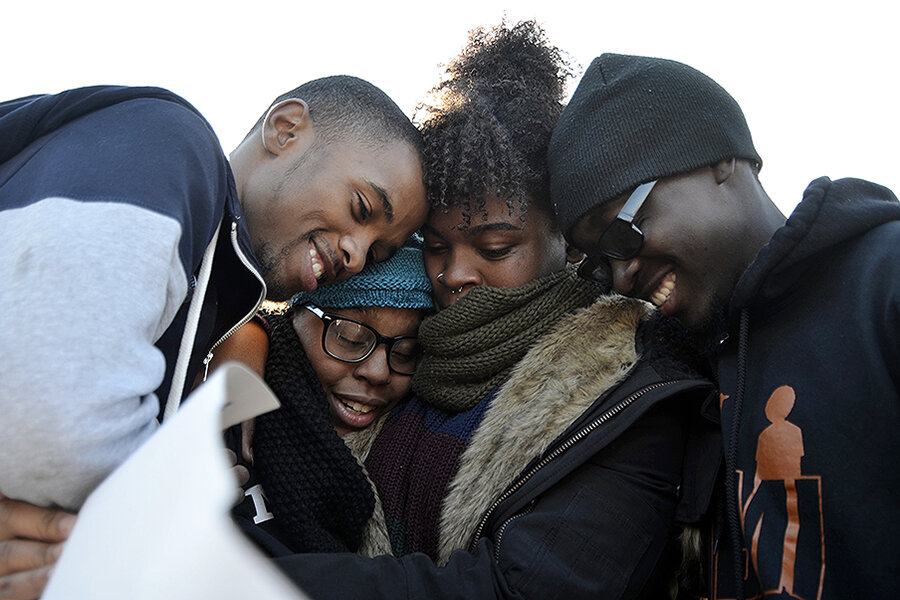University of Missouri protests: What's next?
Loading...
On Tuesday, the day after university president Timothy Wolfe's resignation speech, members of the Concerned Student 1950 movement dismantled the tent city they'd set up one week before on the campus quad, determined to stay put until Mr. Wolfe was gone, after weeks of allegations of unaddressed racist and anti-Semitic incidents on campus.
But the protest wasn't over. With the threat of storms looming overhead, they packed up and moved discussions to a nearby campus center, the Columbia Tribune reports, where students were assured they could spend the night if they did not feel safe, after two confusing and frightening days of threats and rumors, leading to the arrest of two non-students.
In the past 48 hours, news about the Columbia campus has centered on free speech, after some protesters and professors opposed journalists' presence on the Quad, and the threats themselves, which led to many classes, and some businesses, closing temporarily.
But after a closed-door meeting on Wednesday evening, the Board of Curators promised an announcement to come Thursday afternoon, sure to revive debate about what direction the University of Missouri should take to address students' concerns about endemic racial bias on campus.
As the night wore on, local reporter Jared Koller documented hours of student discussion facilitated by the movement leaders, noting that white students were asked to join a separate group at the same site.
News that white and black students were separating to create "healing space" prompted concern on Twitter.
"A movement fighting against racism shouldn’t be practicing segregation," one Tweeter commented, while another countered, "When I don’t get it, I try to keep listening. I don’t get to tell black ppl how to be black, this much I know."
"I think students were able to connect with others," Reuben Faloughi told KOMU-TV:
I think it can be, being at a predominantly white institution, it can be isolating some times. You can feel like you're the only one or nobody else understands your experience, but here I think you can come and share those lived experiences, no matter what color you are and build from there.
But others may have felt less welcome in light of many tweets from the Concerned Student 1950 Twitter account, which appeared to discourage white students from participating in the protests.
"If you are white, you DO NOT get to tell students of color whether their experiences are racist or not. #BlackOnCampus," one white Twitter user said, leading to the Concerned Student 1950 response:
Another white Twitter user wrote "I will never know what it's like to be #Blackoncampus. That means I have a duty to listen to everyone bravely sharing their stories."
Concerned Student 1950 retweeted, adding:
Many students were hopeful that progress would come through new leadership, although, as Coalition of Graduate Workers Co-Chairman Eric Scott said at a rally on November 10, "A few personnel changes do not change the fundamental problems of this university. ...Tomorrow, we need to wake up and we need to keep working."
Several campus groups, from MU Policy Now to the Legion of Black Collegians, have come together in support of retired Deputy Chancellor Michael Middleton, who they believe should be named interim president. During his time at the university, Mr. Middleton was credited with improving faculty diversity, as well as creating the women's studies and black studies departments.
Meanwhile, the campus' Forum on Graduate Rights, which has voiced its support for the Concerned Student 1950 movement, has proposed a number of concrete changes to address the underlying inequalities they say exist for Mizzou students and staff across the board, from parents, to black students, to workers.
At the grad students' Tuesday rally, one proposed extending diversity training beyond university staff. "Compassion and empathy should be part of our curriculum," Timothy Love said.
Graduate students groups have also advocated for better working contracts and health insurance.
"We want to point out the intersections between these different problems," Mr. Scott explained:
While we certainly have lots of problems with the racial climate, there are problems with ableism, with sexism, with homophobia. We want to be sure we’re addressing the needs of all of those communities.








